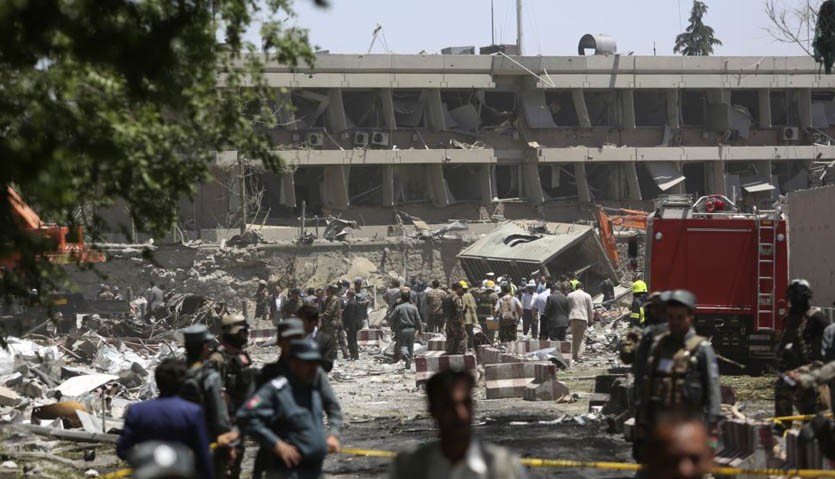
The nation-states have increasingly adopted asymmetrical warfare through the use of non-state actors as a preferred strategy rather than diplomacy or conventional war

State influences the terms of societal behaviour through an elaborate system of policies and laws executed by a set of institutions.
Assessing from the perspective of law and order, state institutions get a yearly budget to safeguard the life and property of its citizens as enshrined in the constitution. For example, Pakistan’s 2017-18 defense budget is Rs920 billion while Punjab’s Public Order and Safety Affairs budget was Rs132 billion (2016-17). Similarly, the US Defense budget is $824 billion.
Then why is it that states with such large resources are not able to root out terrorism from the world? How can non-state actors such as ISIS, al-Qaeda, and Taliban thrive against all powerful states?
Here one is not talking about a lone wolf actor or ragtag insurgents who conduct small operations but of actors who have taken on the state military.
Let’s take the example of ISIS, a terror outfit that captured large swathes of land in Iraq and Syria. Analysts trace the rise of ISIS to the destruction of Iraqi state and disbanding of Iraqi army by the US in 2003. They consider ISIS to be run by members of the disbanded Iraqi military and intelligence officers using religion as a mobilising force to attract the marginalised Sunni population in both Iraq and Syria.
This still does not explain the strength of ISIS, unless one adds facilitation of the Turkish state by buying smuggled oil, in delivery of weapons, and manpower movement through Turkish borders. Further still with the facilitation of the Saudi and Qatari state through funds, and the US state through weapons, given to the Free Syria Army which ultimately found their way into ISIS or Syrian al-Qaeda.
Thus as long as the American state had a stated policy of regime change in Syria, ISIS was a tolerable evil which could be dealt with at a later stage after the fall of Asad. But, it was the states of Iran and Russia which changed the declining fortunes of Asad through resources, weapons systems and boots on the ground.
The point being that the war in Syria was actually an asymmetric war among states -- US-Turkey-Saudi vs Syria-Iran-Russia -- rather than one between ISIS and the Syrian state. ISIS was a tool that these states had allowed to grow for their policy objectives vis-a-vis the Syrian state. As large swathes of land became ungoverned because of the destruction of Iraqi and a receding Syrian states, ISIS filled the vacuum.
It is mostly the same story that repeats itself where one finds terrorism. For example, the recent Saudi bombardment of Yemen is increasing the space for al-Qaeda to take over territories vacated by the Houthi forces. While al-Qaeda targets both Houthi as well as the Saudi aligned Yemeni forces, the wrath of the Saudi forces is focused primarily on Houthis.
The first Afghan War which changed the complexion of Pakistani society was again an example of asymmetric warfare of states of the so-called free world against the Soviet army with Afghans as pawns leading to the destruction of Afghan state and society. Following the US departure, the created militant infrastructure was used by the Pakistani state for asymmetric warfare against India in an insurgency hit Kashmir, while an associated civil war was fought in Afghanistan between the Taliban and Northern Alliance, with Pakistan-Saudi-UAE and Iran-India-Russia supporting opposite sides.
Similarly, the US failure in post 9/11 Afghanistan was partly an outcome of safe sanctuaries provided to the Taliban by the Pakistani state. But the same was not done for most al-Qaeda functionaries who were wanted by the US. This led to a split within the Taliban, with Tehreek-e-Taliban Pakistan (TTP) joining the al-Qaeda camp, and later the ISIS umbrella. Similarly, the Indian state has exploited the Baloch insurgency for asymmetric warfare against Pakistan.
The nation-states have increasingly adopted asymmetrical warfare through the use of non-state actors as a preferred strategy rather than diplomacy or conventional war, when an opportunity has presented itself in the form of an insurgency or ungoverned spaces. Terrorism is but an outcome of this phenomenon funded by the states’ defense budgets.
This brings me to the current situation in Afghanistan where terrorism by Taliban and Islamic State (IS/ISIS) has again become a daily occurrence. But as earlier argued, more than non-state actors, this phenomenon should be assessed through the lens of state interests. Of these, the existing proxy war between Pakistan and India in Afghanistan is critical, which precludes a regional solution to the Afghan crises.
Since we share a border, insecurity in Afghanistan impacts us a lot more than India. Thus, a diplomatic route to end asymmetric warfare in Afghanistan is singly in our interest.